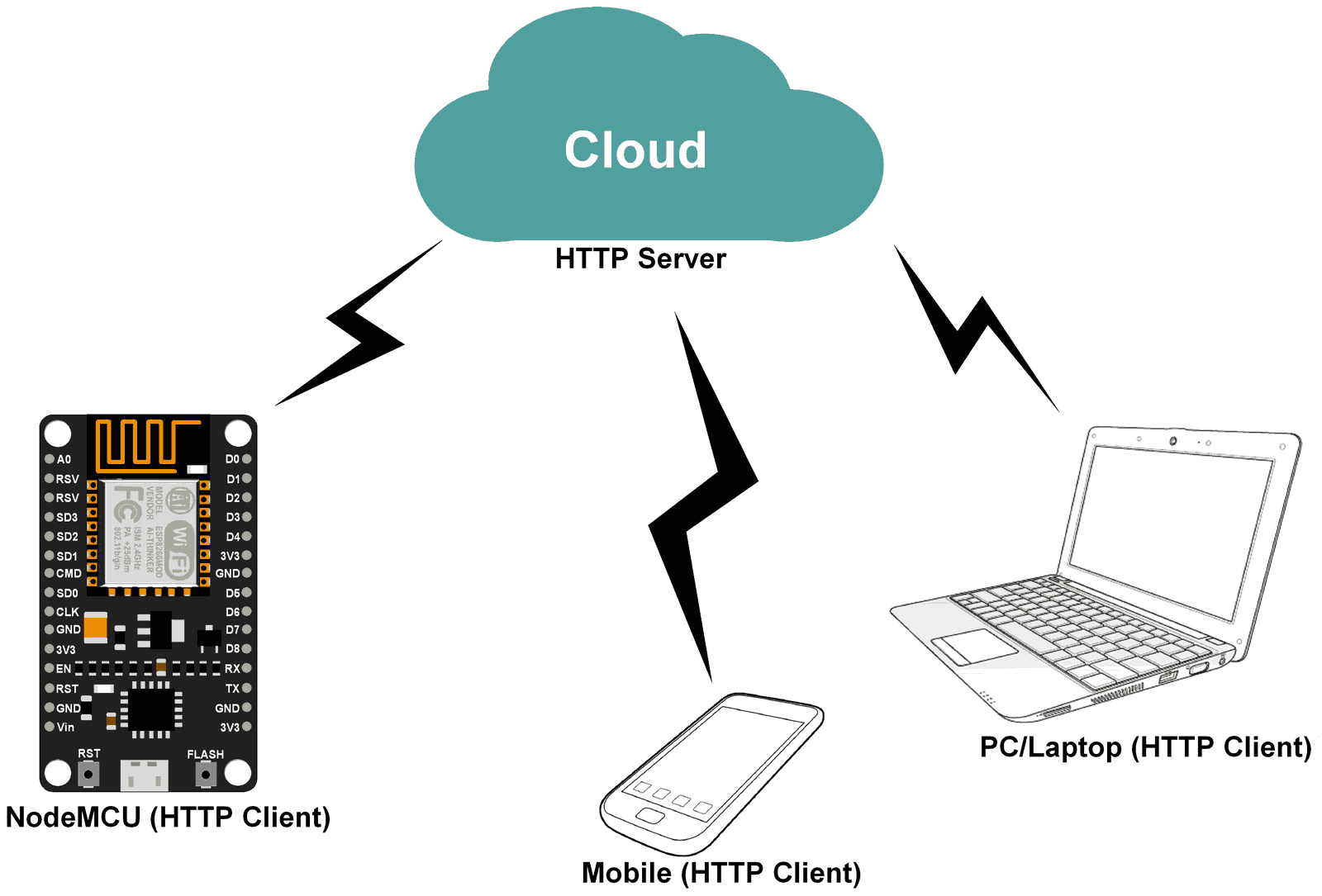HTTP Client on NodeMCU with Arduino IDE
Introduction
HTTP (Hypertext Transfer Protocol) is a standard Application protocol which functions as a request-response protocol between client and server.
HTTP client helps to send HTTP requests and receiving HTTP responses from the HTTP server.
It is widely used in IoT based embedded applications like Home Automation, vehicle engine parameter monitoring remotely for analysis, etc.
NodeMCU is an open-source IoT platform. It is a firmware which runs on ESP8266 Wi-Fi SoC from Espressif Systems. It has onboard wi-fi available through which IoT applications becomes easy to build.

Example
Let’s write a C/C++ based Arduino sketch for NodeMCU as an HTTP Client and GET/POST the data from/to the thingspeak server.
Here, we are using Thingspeak server for HTTP Client demo purpose.
Thingspeak is an open IOT platform where anyone can visualize and analyze live data from their sensor devices. Also, we can perform data analysis on data posted by remote devices with Matlab code in Thingspeak. To learn more about Thingspeak refer link
Just sign up and create a channel. We have below the channel and write key on Thingspeak for data send and receive.
- Channel ID is = 309236
- Write Key is = 1EYZIS5OCRJSKZHG
Note: Do not forget to tick the Make Public field in channel setting option on your thingspeak channel.
ArduinoSketch for HTTP Client Get
#include <ESP8266WiFi.h>
/*Put your SSID & Password*/
const char* ssid = "ssid"; // Enter SSID here
const char* password = "password"; //Enter Password here
const char* server = "api.thingspeak.com";
/* Set GET link with channel ID */
const char* _getLink = "http://api.thingspeak.com/channels/309236/feeds/last.txt";
WiFiClient client;
void setup() {
Serial.begin(9600);
delay(1000);
Serial.println("Connecting to ");
Serial.println(ssid);
//connect to your local wi-fi network
WiFi.begin(ssid, password);
//check wi-fi is connected to wi-fi network
while (WiFi.status() != WL_CONNECTED) {
delay(500);
Serial.print(".");
}
Serial.println("");
Serial.println("WiFi connected");
}
void loop()
{
if (client.connect(server,80)) // "184.106.153.149" or api.thingspeak.com
{
String getStr = _getLink;
client.print("GET "+getStr+"\n");
client.print("HTTP/1.1\n");
client.print("Host: api.thingspeak.com\n");
client.print("Connection: close\n\n\n");
while(client.available()){
char c = client.read();
Serial.print(c);
}
Serial.println("");
}
client.stop();
Serial.println("Waiting…");
delay(10000);
}
Output Window for HTTP Get
Below is the Arduino serial monitor window which shows last updated data received from thingspeak server.

Arduino Sketch for HTTP Client Post
#include <ESP8266WiFi.h>
String apiKey = "1EYZIS5OCRJSKZHG"; // replace with your channel’s thingspeak API key,
/*Put your SSID & Password*/
const char* ssid = "ssid"; // Enter SSID here
const char* password = "password"; // Enter Password here
const char* server = "api.thingspeak.com";
int Sample;
WiFiClient client;
void setup() {
Serial.begin(9600);
delay(1000);
Serial.println("Connecting to ");
Serial.println(ssid);
//connect to your local wi-fi network
WiFi.begin(ssid, password);
//check wi-fi is connected to wi-fi network
while (WiFi.status() != WL_CONNECTED) {
delay(500);
Serial.print(".");
}
Serial.println("");
Serial.println("WiFi connected");
}
void loop()
{
if (client.connect(server,80)) // "184.106.153.149" or api.thingspeak.com
{
String postStr = apiKey;
postStr +="&field1=";
postStr += String(Sample++);
postStr += "\r\n\r\n";
client.print("POST /update HTTP/1.1\n");
client.print("Host: api.thingspeak.com\n");
client.print("Connection: close\n");
client.print("X-THINGSPEAKAPIKEY: "+apiKey+"\n");
client.print("Content-Type: application/x-www-form-urlencoded\n");
client.print("Content-Length: ");
client.print(postStr.length());
client.print("\n\n");
client.print(postStr);
}
client.stop();
Serial.println("Waiting…"); // thingspeak needs minimum 15 sec delay between updates
delay(20000);
}
Output Window for HTTP Post
Below is the output window of counts at thingspeak server.


No comments: